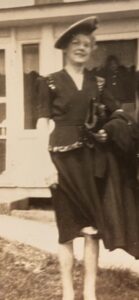On a recent stay with my 86-year-old dad in Ohio, I got to practice checking my impatience and slowing down. Dad loves “visiting,” which means telling anecdotes from random threads of memories. It’s also a practice of kindness and respect for me to listen to the stories.
This practice of watching and adjusting yourself is fundamental to awareness and growth. I want to give you an easy acronym to remember the process, NOSI. To help frame it, we’ll first oversimplify and integrate two fascinating fields, neuroscience and yoga psychology.
Neuroscience has identified discrete parts of the brain that communicate, the Default Mode Network (DMN). The DMN includes “hubs” responsible for where we hold information about the self, how we relate to others, and where we hold memory and simulate the future.
Our DMN function increases during excessive rumination associated with depression and chronic pain. It decreases with trauma when we “check out” and forget what happened. It becomes disrupted in neurological disorders. It appears to be deactivated when we are focused on an external task, inviting a flow state.
Essentially, very simplistically, our brains are wired along habitual routes of thinking, determined by life experiences. Think about how your brain gets stuck on a song or wakes up chewing on yesterday’s problem. Consider how under stress you may habitually reach for chocolate, easy TV, a pet’s furry belly. Emotionally, consider how you automatically respond to a loved one’s face, voice, or presence.
Yoga psychology calls this habitual wiring grooves of the mind and has a systematic array of ethics and disciplines to create new grooves, to upgrade the Default Mode Network. You can use the following NOSI process to help create new grooves in your DMN, essentially upgrading habits and perspectives. Cool, right?
First, Notice. Notice something you’re doing, a way you’re thinking, a response you’re having toward others that isn’t working. It might be a pattern of acting, a limiting belief that keeps you stuck, or how you’re resisting a helpful idea or inarguable fact. You might be experiencing a strong emotion like unhappiness, anger, or fear. This is often the hardest step—to see how my thinking or actions are creating an obstacle to my success, effectiveness, or happiness.
Second, after getting it, Observe. This is distinct from Notice in that Observing is ongoing over a period of time. You’ll notice tension in a meeting, then observe yourself handling it over the next two hours. You’ll notice you’re having difficulty with a relationship, then observe your responses, habits, and patterns over the next month. It’s critical to give the Observing stage enough time. It might be a few minutes; it might be months.
After collecting enough data from Observing, make a Shift. You notice a partner or colleague is ignoring something you value. You observe YOUR response and behavior for as long as you need. Then you create a shift, the pace of which and how we shift is another topic. Again, if you have a deeply-held pattern or belief, it will take time to re-wire your brain. You might adjust an expectation, make a request, or let go of an outdated structure, action, or belief.
Finally, Iterate. Observe and repeat. That shift will probably need tweaked. Give yourself permission to do the first three steps knowing that a shift can be repeated and adjusted. Make room for some massive imperfect action. This step might help the most in re-wiring the DMN. Changing most habits, actions, and beliefs takes repetition and time.

The Murdock Cemetery near Waterford, OhioTo help me make the shift, I suggested we go find the independent and fashionable Great-Aunt Maude. I knew he’d enjoy driving around the countryside searching out ancient cemeteries and telling me stories prompted by the drive.
Back to my dad. I noticed my impatience with the stories. For a week I observed myself wanting straight answers instead of winding stories, avoiding questions or comments that might prompt a trip of memories, and once actually requesting a 30 second story limit.
I relaxed into the rhythm of driving back roads around farms and woods, strolling through rows of tombstones surrounded by pastures, stopping for ice cream at an Amish shop, and whooping in delight when we finally found Aunt Maude. I thanked her for the beautiful ring that came down to me. Not much time for iterating—that will be the next trip.
So, go be NOSI with yourself, and invite others to the framework. It’s easy to remember, and basic to being conscious. You can also be like my dad—the process of shifting might make a good story!

Aunt Maude Murdock

Aunt Maude’s Farmhouse



